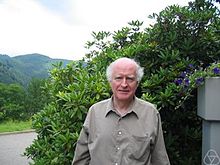John Mather (mathematician)
| John N. Mather | |
|---|---|

Mather in 2005
|
|
| Born |
John Norman Mather June 9, 1942 Los Angeles, California |
| Died | January 28, 2017 (aged 74) Princeton, New Jersey |
| Residence | United States |
| Nationality | American |
| Alma mater |
Harvard University Princeton University |
| Known for |
Smooth functions Topologically stratified space Aubry-Mather theory Mather theory |
| Awards |
John J. Carty Award for the Advancement of Science (1978) National Order of Scientific Merit (Brazil) (2000) George David Birkhoff Prize (2003) Brouwer Medal (2014) |
| Scientific career | |
| Fields | Mathematics |
| Institutions |
IHES Harvard University Princeton University |
| Doctoral advisor | John Milnor |
| Doctoral students |
Giovanni Forni Vadim Kaloshin |
John Norman Mather (June 9, 1942 – January 28, 2017) was a mathematician at Princeton University known for his work on singularity theory and Hamiltonian dynamics. He was descended from Atherton Mather (1663-1734), a cousin of Cotton Mather.
His early work dealt with the stability of smooth mappings between smooth manifolds of dimensions n (for the source manifold N) and p (for the target manifold P). He determined the precise dimensions (n,p) for which smooth mappings are stable with respect to smooth equivalence by diffeomorphisms of the source and target (i.e. infinitely differentiable coordinate changes).
He also proved the conjecture of the French topologist René Thom that under topological equivalence smooth mappings are generically stable: the subset of the space of smooth mappings between two smooth manifolds consisting of the topologically stable mappings is a dense subset in the smooth Whitney topology. His notes on the topic of topological stability are still a standard reference on the topic of topologically stratified spaces.
Since 1970s, he switched to the field of dynamical systems. He made the following main contributions to dynamical systems that deeply influenced the field.
1. He introduced the concept of Mather spectrum and gave a characterization of Anosov diffeomorphism.
2. Jointly with Richard McGehee, he gave an example of collinear four-body problem which has initial conditions leading to solutions that blow up in finite time. This was the first result that made the Painleve conjecture plausible.
3. He developed a variational theory for the globally action minimizing orbits for twist maps (convex Hamiltonian systems of two degrees of freedom), along the line of the work of G. D. Birkhoff, M. Morse, G. A. Hedlund, et al. This theory is now known as the Aubry-Mather theory.
...
Wikipedia
